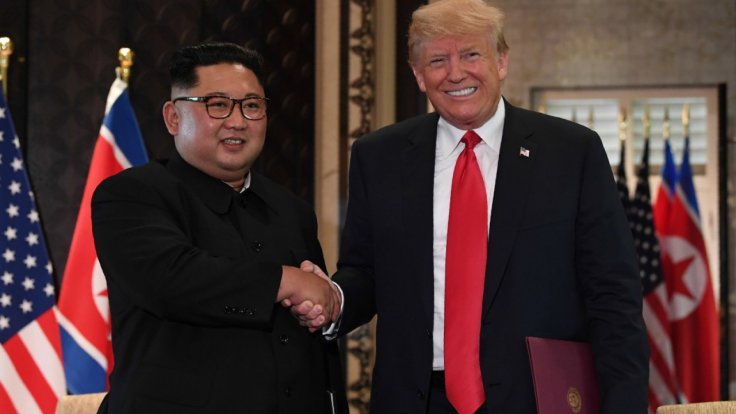North Korea is all set to spite the United States by building a multi-warhead intercontinental ballistic missile if talks with Washington fails, defence experts have said. President Donald Trump unleashed a charm offensive on reclusive leader Kim Jong-Un last year but denuclearization talks hit a bumpy road since then. Should the talks fail, Pyongyang would want to display its power to strike at the US with greater force and precision, experts said.
A South Korean think tank said in a report published on Monday that the engine tests for ICBMs Pyongyang conducted earlier this month hold clues to the regime's further plans. The think tank argued that the upper part of the Hwasong-15-class ICBM tested in November 2017, which had a round stubby shape, suggests that Pyongyang wants to develop a multi-warhead missile.
"This means that North Korea wants to send heavier nuclear materials farther. The higher the engine thrust is, the heavier the warhead it could carry and the more likely it is to be intended for multiple warheads," the report from the Korea Institute for Defense Analyses said, according to Chosun Ilbo.
Amid rumours of provocative action, Pyongyang said on Saturday it successfully performed another "crucial test" at its long-range rocket launch site

North could go this route as a pressure tactic against the US, the report says. If this plan materialises, North Korea will become only the sixth country after the US, Russia, China, the UK and France to have ballistic missiles capable of carrying multiple warheads at a time.
What is a multi-warhead missile?
Multiple Independent Reentry Vehicles (MIRV) is a nuclear warhead carried on the front end, or "bus," of a ballistic missile. Encyclopaedia Britannica explains it thus: "Each MIRV allows separately targeted nuclear warheads to be sent on their independent ways after the main propulsion stages of the missile launch have shut down. The warheads can be released from the bus at different speeds and on different trajectories. MIRV technology was first developed by the United States. By the late 20th century both the United States and the Soviet Union had many intercontinental and submarine-launched ballistic missiles equipped with MIRVs."
Is it a scare tactic?

North Korea, which has been slapped with heavy United Nations and US sanctions over its ballistic missile programme, harbours fears over a possible US invasion. Missile and weapons testing are a means for North Korea to show that it's undaunted by the US firepower and diplomatic might.
Leader Kim Jong-Un had said in 2017 that his country was close to test-launching an ICBM. Pyongyang upped the ante this year, saying it can launch an intercontinental ballistic missile "anytime and anywhere".
Will talks re-start?
South Korean media had reported weeks ago, citing sources in the country's spy agency, that North's phlegmatic leader Kim Jong-Un was expecting to hold a bilateral summit with US President Donald Trump at the end of November or in December. Pyongyang-Washington talks have been in a limbo ever since the 'break-up' in early October. President Trump met Kim Jong-Un for the first time at a historic summit in Singapore in 2018. The new round of talks, if it takes place, could focus on denuclearization efforts, the report had said.
A nasty 'Christmas present' coming?

Talks have been doing the rounds over a nasty Christmas present Pyongyang would offer Washington. Amid rumours of provocative action, Pyongyang said on Saturday it successfully performed another "crucial test" at its long-range rocket launch site. Defence experts believe that the tests were aimed at improving the North Korean ICBM that can strike at the heart of US mainland.
Pyongyang upped the ante this year, saying it can launch an intercontinental ballistic missile "anytime and anywhere".
Recent missile tests
North Korea has made significant advancement in missile technology in recent years. Pyongyang tested Hwasong-12, which has a range of 4,500km, in April 2017. With this, the regime apparently gained the capacity to strike US military bases on the Pacific island of Guam. This was followed up with the testing of Hwasong-14, which is thought to have the capability to travel 10,000km. This range could put New York within striking distance from North Korea. Pyongyang also then tested the Hwasong-15, which peaks at 4,500km, which is 10 times higher than the International Space Station, BBC reported.









